|
FAQs about Marine Crab (Including some Anomurans)
Identification 18
Related Articles: Crabs, Hermit
Crabs,
Related FAQs: SW Crab Identification 1, SW Crab ID 2, SW Crab ID 3, SW Crab ID 4,
SW Crab ID 5,
SW
Crab ID 6, Marine Crab ID 7,
Marine Crab ID 8, Marine Crab ID 9, Marine
Crab ID 10, Marine
Crab ID 11, Marine
Crab ID 12, SW Crab ID 13,
SW Crab ID 14, SW Crab ID 15, SW
Crab ID 16, SW Crab ID 17,
SW Crab ID 19,
SW Crab ID 20,
SW Crab ID 21,
SW Crab ID
22,
& Marine Invertebrate
identification, Marine Crabs
1, Marine Crabs
2, Marine Crabs 3, Marine Crabs 4, & Crab Behavior, Marine Crab
Selection, Marine Crab
Compatibility, Marine Crab
Systems, Marine Crab
Feeding, Marine Crab
Reproduction, Marine Crab
Disease, Micro-Crustaceans,
Amphipods, Copepods, Mysids, Hermit
Crabs, Shrimps,
Cleaner
Shrimps,
Banded Coral Shrimp,
Mantis Shrimp,
Anemone Eating Shrimp,
Crustacean Identification,
Crustacean
Selection, Crustacean
Behavior, Crustacean
Compatibility, Crustacean
Systems, Crustacean Feeding,
Crustacean Disease,
Crustacean Reproduction,
|
 |
|
Hitchhiker ID 11/17/14
What in the world kind of crab is this?? He just showed up one day!
Can't find anything on him!
<Mmm; this 6 kB file is too small to make out much.... could/would you
send along one of a few hundred kBs? Are the ends of the claws of this
animal black/ish? My (family) guess is on the Xanthidae... See WWM, the
Net re. Bob Fenner>
|
.jpg) |
|
coral guard crab
4/15/12
Dear Wet Web Crew,
<Hi Wendy, Jordan here>
I’ve purchased a 3” Stylophora and have just found that it
contains a commensal crab.
<Nice freebie.>
From the size and shape of it I believe it to be Trapezia.
The coral and crab are currently in quarantine, but will go to my
180 gal reef tank afterward. I would like to know if you
would consider the crab a hazard to any other corals (or fish),
and your opinion on whether the small colony of Stylophora would
do better with or without it?
<I would leave the crab in the coral. The Stylophora is large
enough to withstand any damage the crab may inflict. Smaller SPS
should be safe as the crab is going to find the larger colonies.
It will threaten fish which venture to close to its home but
it's too small to do any real damage.>
I have read that these crabs eat coral mucus as well as coral
flesh and that this may be detrimental for a small colony, but
also helpful for growth, and that they may migrate to another
coral at night, but only reside in Pocillopora or Acropora (but
am wondering if they really may go into other corals as well such
as a Tubastrea?
<They will stick to SPS.>
I have a very nice Tubastrea which I would not want the
crab to damage.
<Tubastrea would likely eat the crab if it tried.>
My reef tank also contains another 3” Stylophora, a couple of 8
inch Staghorns, a few Birdsnests, plus other assorted LPS and
Mushrooms, and an assortment of fish (Argi, Tangs, Anthias,
Fairy Wrasses, Gobies, Chromis, Clownfish) .
Thank you for your advice,
<Quite welcome>
Wendy
<Jordan>
Trapezia crab id 4/15/12
Dear Crew,
<Wendy>
Attached is a picture of my hitchhiker guard crab which I wrote
of earlier.
Could you comment on whether this crab appears to you to be
a Trapezia, or other ?
< I suspect it is Trapezia digitalis but it is difficult to
say for certain based on the picture. It is either a Trapezia sp.
or Tetralia sp. The two can be easily differentiated by there
claws. Trapezia sp will have claws equal in size; Tetralia sp
will have one claw larger than the other. Tetralia sp are also
smaller and will only host Acropora, Trapezia sp are not as picky
as to which stony coral they call home. Nice hitch-hiker
regardless of genus>
Thanks,
<Quite welcome>
Wendy
<Jordan>
|
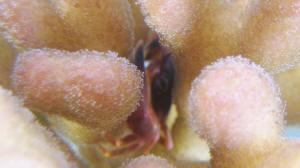 |
|
Crab id
4/14/12
Bob,
<Eric>
Have you ever seen a crab like this before?
<Mmm, yes>
It looks like a real hairy manthrix crab.
<... Mithrax/Mithraculus...>
It has white pinchers and green eyes. I saw it
hanging around one of my rocks but was not able to catch
it. I have not added any rock or corals other than a few 1
inch frags so this guy must have been in my tank for
sometime. I do have about 5 emerald green crabs but the
color and fuzzy appearance are throwing me off here. Any
thoughts?
Eric
<I'd remove it to elsewhere. See WWM re Decapod ID and
compatibility. Bob Fenner>
|
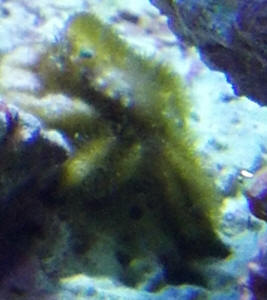 |
|
identification on this crab
please 4/14/12
Hi I was recently rescaping my reef aquarium and came across this
interesting little specimen. He was clinging to a small rock at
the base of the aquarium, i do not think this was where he was
originally sitting but had made do after me moving things about.
In my humble opinion he seems to be a coral crab of some form, as
he is trying to hold onto objects using his rear legs. I
don't know how well you can see the image, it is of his
carapace, which seems to be concave with a peak in the centre.
Markings are brown freckly pattern on a white base. Its face is
also rather strange to me, very white with two very distinct
black eyes, spaced very far apart and very small. No other facial
features are immediately apparent. The crabs pincers are very
thin, almost like a decorator crabs but on a smaller scale, again
pure white in colouration. I do not think it is a coral predator,
but would nevertheless like it identifying purely to satisfy my
curiosity if nothing else. Thank you in advance. Liam
<Due to physical characteristics, I'd guess this to be a
Pinnotherid species... Bob Fenner>
|
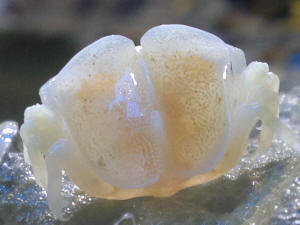 |
|
Crustacean Identification: Coral Crab –
3/11/12
Hello WWM Crew
<Hello Chris, Lynn here this evening.>
I just brought home a new frag from my LFS that came with a
hitchhiker, see the attached image.
<Was the frag a stony coral like a Pocillopora or Acropora sp.
by any chance?>
I looked through the FAQs, crab identification page and some
Googling and couldn't locate a similar crab.
<It appears to be a coral crab, probably in the genus Tetralia
or Trapezia (family Tetraliidae and Trapeziidae respectively).
Please see the following links for comparison and more
information re:
http://www.chucksaddiction.com/coral_crabs.html
http://www.fishchannel.com/saltwater-aquariums/reefkeeping/guard-crabs.aspx
http://news.mongabay.com/2006/1023-ucsb.html
>
Please help me decide this little critters fate, I'm
wondering if he is reef safe or should be disposed of.
<I would try to keep it, but only if the frag it's
inhabiting is large and healthy. These crabs consume coral mucus
and the occasional polyp. A single crab on a large colony
shouldn't have much noticeable (negative) impact, but that
same crab on a small colony could really leave a mark, so to
speak. Do please read the above-listed article at the second link
for more information regarding the care and needs of these crabs.
If after reading you find that you're not able to keep the
crab, then I would suggest trying to find it a new home, either
by returning it to the LFS or by giving it to a fellow hobbyist
with an appropriate system.>
Thanks,
<You’re very welcome.>
Chris Meyer
<Take care, Lynn Z>
|
|
[1].JPG)
|
|
Sw crab id 2/28/12
I have searched over all of your crab identifications and was not
able to find a crab that looks similar to the one i have
found.
<Mmm, there are more than 4,500 species of true crabs>
It was on the underside of a small piece of rock at my
work. It was coexisting with emeralds peppermint shrimp and Condy
anemones.
<Perhaps for now>
It is a zebra black and white with small red pincers and is
about the size of a dime(max). I took it home and secluded him to
my refuge. It is an interesting specimen and would like to put it
in my display, but fears of him eating coral ( i know there's
a risk with any crabs at some point) keep me from doing so. The
pic is a zoomed in close up in a specimen container and the
accompanying piece of rock is nothing more than a small piece of
crushed coral ( size reference).
<I see this in your further email. A beauty, and one I've
not seen before>
Like i mentioned he has been put in my refuge so no worries, but
an id would be great!
<I agree... with the wish and your movement/isolation of this
animal. Let's see if someone else chimes in rather than my
spending tens of minutes perusing my in-print references. Bob
Fenner>
~Seth
|
|
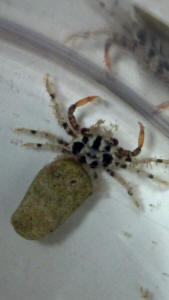 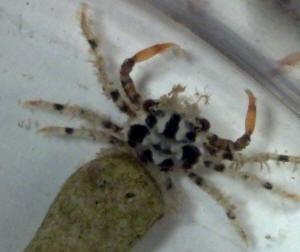
|
|
Mystery Crab, ID 2/7/12
Hello crew.
<Howdy!>
First, thank you for the most helpful site out there. I
"adopted" a reef tank (if you can even call it a reef
tank in the condition it was in) from Craigslist and it has been
a long and winding road back to relatively pristine conditions
which have involved untold trips back to your site to figure out
what is going on and what to do about it (PopEye, phosphate
spikes, diatom blooms, Ick, cooking LR, sump redesign, QT tanks
etc.) Your site helped me make it through each of the issues with
very little tragedy along the way. So on behalf of the Perc, two
tangs, coral beauty and damsels who are now living the good life,
thanks.
<A collective welcome to all>
As an adopted tank, I find strange things from time to time. Last
night, I finally caught the crab I've seen out a few times
since I got the tank back to healthy. Picture attached. At first,
I figured he's yet another strange hitchhiker (I've
already relegated two HUGE decorator crabs to the fuge) but on
closer look think he might be a white emerald. Any thoughts?
<Mmm, is almost assuredly a Xanthid... Someone sent in a very
similar pic back in 08 to the WWForum:
http://wetwebmediaforum.com/showthread.php?401-Critter-of-the-Week!-Gorilla-Crab-(standing-in-for-Lynn)>
He's in the refugium until I'm sure.
<Can be dangerously "picky"... good that you've
moved it>
Also, I have a few Ricordea in there, most are very happy and
colorful, but one is small and pretty bleached out. Is it OK/good
to move it under a rock ledge to get it a bit of a break from the
lighting?
<Yes>
Any supplement/food I can direct apply to help it perk up?
<Vitamins, HUFA supplement soaked small meaty bits. Please
read here re:
http://www.wetwebmedia.com/shroomfdgfaqs.htm
Thanks again,
<A revolving welcome/acknowledgement. Bob Fenner>
Nick
|
|
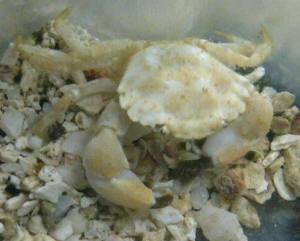
|
|
Crab ID 12/9/11
Hi, any idea what type of crab this is?
<Perhaps a Pinnotherid. Bob Fenner>
Thank you
|
|
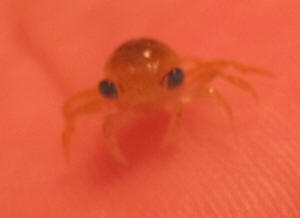
|
|
Re: Snail: Gemophos spp. Whelk, now Crab ID -
9/20/11
Thanks Lynn!
<You're welcome!>
It is an office tank, so viewing at night will be tough,
<Oops, I wasn't thinking when I made that
suggestion!>
...but I guess I'll come to the office some evening and check
it out with a red flashlight or something.
<Yep, or since it's a small tank, you could fake night
hours by taping opaque sheets of paper to the front/sides of the
tank and turning out the lights. After a couple of hours, remove
the front sheet and see what's out and about (before it goes
back into hiding!).>
I did remove what seemed to be a dead crab that was about the
size of a dime about a week ago. It had black-tipped claws and
looked to me like a Xanthid or Gorilla crab of some sort. Are
they found in Florida LR?
<Yep>
Many years ago, one of my hermits molted which I confused for a
dead crab (when I was a noob), which was found alive and well
later that day.
<I think that's happened to just about all of us. They
really can fool you.>
I believe it's possible that I am confusing the
"dead" crab for the molted shell of a crab alive and
well in my tank.
<It could well be.>
If it is in-fact a crab and I am able to capture it, what would
you suggest that I do with it?
<If you have another tank at home with a sump, I'd put it
in there. Otherwise, you could offer the crab to a local fish
store or to someone in a local aquarium club.>
Would this type of crab be the most likely suspect in the assault
on my button polyps and algae?
<It's possible. Some Xanthids do prey on polyps. It's
also possible that it could be another culprit entirely, like a
Nudibranch, or something related to water quality or light issues
(too much/too little/sudden change). It's also possible that
something eating the algae is bulldozing over the polyps and
causing damage. If you can rule out water quality/light issues,
check the area around those polyps (especially around the base) a
few hours after lights out for the presence of any predators. As
for the algae, it depends on whether it looks like it's being
eaten (ragged edges, nipped stalks/parts, etc.), nipped
at/bulldozed (usually = broken stems and/or loose pieces
scattered about), or just overall dying back. I'm not sure
how long you've had your tank set up, but I can tell you that
it's typical to see macros come and go at first. The ones you
really want to watch for with the Florida rock are the Caulerpa
species and another red macro that I haven't been able to ID.
Here are a couple of links to photos:
http://wetwebmediaforum.com/album.php?albumid=16&attachmentid=1702
Close-up of the red macro: http://wetwebmediaforum.com/album.php?
lbumid=16&attachmentid=1703 . If you see either of these two
macro's, get rid of them! >
Thanks again!
<You're welcome!>
Jeremiah
<Take care, Lynn Z>
Follow-up Re: Snail: Gemophos spp. Whelk; Now Crab ID --
9/20/11
<Hi Jeremiah.>
One of the claws was still in the tank. With the help of my
magnifying glass, I got a pic. Hope this helps assess my predator
situation.
<I wish I could say that it was the piece of the puzzle I
needed, but no such luck. Offhand, I'd say that the claw
appears to be that of a Xanthid or Pilumnid. No matter what type
of crab it is (with the exception of
Anomuran/'false'/'Porcelain' crabs), I'd
still remove it if/when you are able to trap or net it. By the
way, Porcelain crabs do occasionally hitchhike into tanks via
rock from Florida but I do not think that's what you have.
One quick way to tell the difference is that true crabs
(Brachyurans) have 4 pairs of walking legs while false crabs have
3. Hope that helps!>
Jeremiah
<Take care, Lynn Z>
|
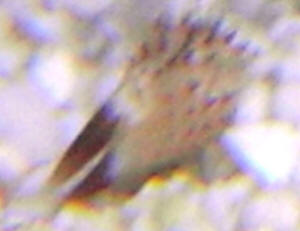 |
Re: Follow-up Re: Snail: Gemophos spp.
Whelk; Now Crab ID -- 9/20/11
<Hey Jeremiah!>
Thank you for your response.
<You're most welcome.>
I killed the tank lights this afternoon and noticed some movement
(no fish or other inhabitants, just LR, hitchhikers, xenia, polyps,
and Zoas). I saw 3 or 4 hairy legs coming out of a hole
<Those sound like brittle star arms. They typically extend out
into the current in order to catch passing bits of food.>
..by where I found what was thought to be a dead crab. Sure enough!
I have a gnarly looking crab!
<Yowzah!>
When I moved closer to take a look, he retreated very fast.
<Yep>
Guess I'll be fabricating a crab trap. Thank you for your help
and if you have any tips on making a small trap, please share.
<The best thing to do is perform a search using our Google
search engine at the bottom of this link:
http://www.wetwebmedia.com/googlesearch.htm .>
When I have him in custody, I will share a photo that you can ID
and post on your crab ID page.
<Sounds good -- oh and good luck trapping the little
guy!>
WWM rocks!
<Woohoo!>
Jeremiah
<Take care, Lynn Z>
|
Unknown crab 7/26/11
Good morning me again, so sorry to keep asking questions.
<No problem.>
Last night I spotted for the first time a little crab of
beige/whitish/greeny colour with small hairs on his legs, he is the
size of a 1 pence piece maybe a little larger, he has four legs and a
pincher on each size and is flat. I have searched the Internet to find
out what he could be and the only thing he resembles is a emerald crab
but is not that green, so I was wondering what he could be and if he is
safe? He was eating particles of the rock work and when my carpenters
flasher wrasse swam very close to him he didn't care just maybe
backed of a little in to a hole.
I do hope you can help me a little further and I look forward to your
reply from one of you brilliant people.
Thank you from Jennie Bailey, England.
Sent from my iPad
<Generally crabs are opportunistic omnivores, so they can become
problematic. If you can get a picture perhaps we can get our resident
expert Lynn to take a look. Take a look through the crab id FAQs and
see if you ca find a close match. http://www.wetwebmedia.com/swcrabidfaqs.htm
.>
<Chris>
Crabs, ID... no rdg. 6/15/11
> Hi Crew,
> I hope you are doing well. I wanted to get identification on a
couple of crabs. I tried to search online and on your website but was
not able to convince myself that the grab I wanted to identify was in
one of the many crab pictures I browsed through.
> I have had my tank running for over 2 years now. I did not
personally put the two crabs I want to be identified in my tank. They
might be hitchhikers when I bought the live rock from someone else.
Please let me know if these are harmful for my reef tank and if should
try my best to remove them from my tank or put them in my sump. I hope
the pictures I have taken are clear enough for the crabs to be
identified.
> Thanks in advance for your help!
> Kind Regards,
> M. Junaid Shaikh
Please re-size and re-send your msg. and graphic. Your 15 plus megs
have been deleted. B
Sorry for the large attachments. Attached are the re-sized images.
<These images are too poorly resolved/blurry to id these decapods to
species. The one "dark-tipped clawed crab" you can id to
family by using the site. Read here: http://www.wetwebmedia.com/SWCrabIDF17.htm
and the linked files in the series (above). Bob Fenner>
Regards,
Junaid
Re: Crabs -- 06/17/11
Thanks for the info. I will try and catch them if I can and put them in
my sump. Its so hard to catch them since they only come out at
night!
<Ah yes. Read here: http://wetwebmedia.com/swcrabcompfaq3.htm
and the linked files above re traps... BobF>
|
Re: Hair turning red 5/2/11
Hi once more,
<Ian>
After the clarification I decided to give the algae a
"hair-cut" to remove the red-encrusting ends.
<Mmm>
I did this in the presumption that the red was not desirable but
with hindsight I'm not sure why I thought that. Was that a
correct assumption - that the red encrusting algae is bad?
<Is not "bad" for your system... a bit of natural
succession. Is bad for the "maiden hair" algae... in
that it will slow down its growth somewhat...>
There seems to be a lot of conflicting opinions on the internet
regarding this and I'm not sure which to believe.
<Then do nothing till you understand>
Anyway, whilst attempting a hair-cut a crab scuttled out from
underneath.
It's about 2.5cm across and seems to have lost a claw. The
nearest thing I can find on your ID pages is Lissocarcinus
laevis
<Nah>
but I cannot find information about whether or not he is
desirable in a reef tank with fish and other invertebrates. I
have attached a photo.
<Most Decapods are not... if this one isn't doing any
apparent damage, I'd leave it be; enjoy it>
Kind regards,
Ian
>And you, B<
|
|
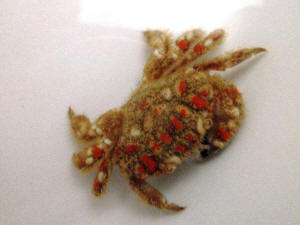
|
|
Re: Hair turning red, crab non-ID
5/2/2011
Hi,
Thanks for the reply but could you expand upon "nah" a
little please?
<Not this species. B>
Kind regards,
Ian
|
|
Crab Identification: Xanthid, Possible Chlorodiella
spp. -- 3/30/11
Good Evening WWM crew!
<Good evening, Tom!>
This crab hitchhiked to me in an Acropora colony.
<The little sneak!>
I am not sure what it is and have quarantined it until I know an
ID and if it is reef safe. Can you help?
<I'll sure try. Your little fellow looks a whole lot like
a species of Chlorodiella, which is a type of Xanthid (family
Xanthidae). Mind you, there are a ton of crabs out there, but
yours has the same overall look/shape, with slightly hairy legs,
and dark, fairly robust claws with spoon/spatulate tips. At least
the claws in your terrific photo hint at being spoon-tipped! This
type of claw tip is excellent for scraping algae, etc., off hard
surfaces, grasping filamentous algae, and for scooping up soft
materials. These crabs tend to be a bit better risk in reef
tanks, but they're still opportunistic omnivores that may be
fairly well-behaved when small and well fed, but can be a problem
later on as their bodies and appetites grow. All things
considered, especially given the fact that the crab has already
been removed, I'd find it another home. Please see the
following links for examples of Chlorodiella species:
http://calphotos.berkeley.edu/cgi/img_query?enlarge=4444+4444+0907+0268
http://www.meerwasserwiki.de/w/index.php/Datei:Chlordiella_cytherea.jpg
>
Thanks, Tom M.
<You're very welcome. Take care, Lynn Z>
|
|
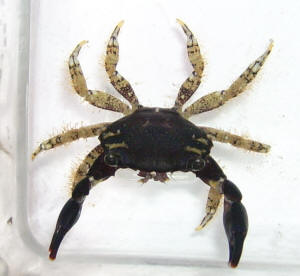
|
Re: Crab Identification: Xanthid, Possible Chlorodiella
spp. -- 3/30/11
Thanks Lynn!
<It was a pleasure, Tom! Take care, Lynn Z> |
|
Crab: Persephona mediterranea - 3/22/11
<Hello Ginger, Lynn here today.>
Can you identify this crab for me? I see them at Dayton Beach all
the time.
<It appears to be Persephona mediterranea (family:
Leucosiidae), aka the 'Mottled Purse Crab'. These crabs
are commonly found around Florida, where they bury themselves in
the sand with only their eyes showing. The term 'purse
crab' is derived from the female's unusually large
abdomen, which is used to hold eggs underneath the body until
they're ready to be shed. For more photos/info, please see
the following links: http://www.jaxshells.org/slife7.htm
http://www.gsmfc.org/seamap/picture_guide/Crabs/persephona.pdf
Photos showing the abdomen of a gravid/egg-bearing female:
http://www.okeefes.org/Crabs/crab_photos.htm
>
Ginger Cole
<Take care, Lynn Zurik>
<<Thank you Lynn! I couldn't find this Decapod in any
of my TWA ref.s, or online. B>>
Re: crab 3/23/11
<<Thank you Lynn! I couldn't find this Decapod in any
of my TWA ref.s, or online. B>>
<You're welcome, Bob! Luckily, I'd seen those little
guys before on the beach - and geek that I am, I had to know what
they were. Heeee, it would have been handy had I remembered what
the scientific name was, but no such luck. All I remembered was
that they were called purse crabs! Take care - Lynn>
|
|
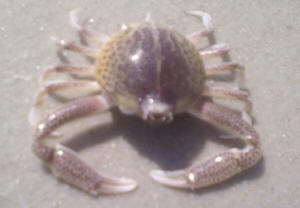
|
|
Identifying Crab from the Keys: Likely Mithraculus sp.
-- 3/6/11
Hi WWM,
<Hi Joe, Lynn here today.>
You guys are always a great help to me. I went on vacation to the
Florida Keys
<Bet that was fun!>
..and brought back a cowry snail, flame scallop,
<Uh oh, these scallops are very hard to keep. They tend to
settle in caves, crevices, or behind rockwork. It makes feeding
them very difficult so sadly most starve to death. Please see the
following link for more information: http://www.wetwebmedia.com/flamescallopfaqs.htm
>
..and a crab snuck in the mix with the very small piece of rock I
took for the scallop and snail on the way home.
<The crab appears to be a species of Mithraculus/Mithrax,
possibly Mithraculus/Mithrax forceps (aka the Red-Ridged Clinging
Crab). Please see the following links for comparison (color
varies):
http://www.wetwebmedia.com/Arthropoda/CrustaceanPIX/SWCrabs/Crab%20IDs/SWCrabs2.htm
http://0.tqn.com/d/saltaquarium/1/0/d/Q/1/kdickredcrab_600.JPG
http://reefguide.org/keys/pixhtml/redridgedclingingcrab2.html
>
I was watching my tank a week later and noticed this new creature
who hitched a ride back with me. Six months later he has gotten
pretty big and my snail population has diminished (no surprise to
me) also my corals have started disappearing/falling apart.
<Crabs are opportunistic omnivores that will eat just about
anything if hungry enough and given the chance. Unfortunately,
that can sometimes include corals and snails. However, it's
also possible that the decline in both is due to something else
entirely -- water conditions, other livestock/pests, allelopathy,
disease, lack of food, etc.>
It started with my tree corals (2 types Capnella and a different
kind) and then my green star polyps started to vanish.
<Yikes. I'm guessing you've ruled out the other
possibilities?>
This may have been due to slight negligence and overdue light
bulbs which I switched out but it was too late for the tree
corals.
<I'm sorry to hear/read that.>
Some of the star polyps are still there and hopefully will come
back. I am not sure if this was caused by this crab and/or this
big cowry snail I found.
<It could have been from a combination of things. As for the
cowry, it could be an omnivorous species that's mostly
herbivorous but won't hesitate to 'sample' other
foods if/when its preferred food runs low. With that in mind, you
might want to try supplementing its diet with a piece of dried
Nori/seaweed sheet rubber-banded to a rock and/or move the cowry
to a separate system if you find that it is indeed going after
the corals. One other issue with cowries in particular is that
some get surprisingly large and can turn into real bulldozers, so
watch out. By the way, if you'd like to pursue an ID for more
specific information, try the following link. It's probably
one of the five species shown:
http://z14.invisionfree.com/Conchologist_Forum/index.php?
showtopic=458
More photos here: http://www.shelltrips.com/KeyWest/pics.html
>
Do I have anything to worry about? Will the crab eat my fish
eventually?
<Well, nothing would surprise me when it comes to what a crab
can or will grab and eat. Keeping it well fed with meaty bits (of
marine origin) like clam, shrimp, fish, etc., and/or sinking
pellets should help discourage it from sampling your livestock,
but all things considered, the crab would be better off in a
separate system or sump. Check out the FAQ titled 'Emerald
crab eating soft coral picture 9/17/10' at the following
link: http://www.wetwebmedia.com/mithraxfaqs.htm
>
I also am having a problem keeping Xenia alive, even when I have
thriving corals doing great, still have mushrooms and looking
good.
<Heeee! Been there, done that. I can't keep Xenia no
matter how hard I try. I have friends that can't get rid of
the stuff fast enough, but not me, no sir. I'm honestly not
sure why it does so well in some systems and not in others, but
you might want to check out the FAQ's related to Xenia
health, starting here: http://www.wetwebmedia.com/xeniiddisfaqs.htm
>
Thanks for all your help!
<You're very welcome!>
Joe
<Take care, Lynn Z>
|
|
[1]%20crab.jpg)
Soon to be much, MUCH bigger
|
|
Peruvian shore crab identification
2/20/11
Hi crew,
Can you please help me to find which species is this well
camouflaged shore crab seen on the beach just south of Lima, Peru
in mid-June last year?
Best regards,
Peter
<It's a Grapsid crab of some sort, perhaps Aratus pisonii.
Note the sharp, pointed legs adapted to climbing rather than
swimming, especially the final pair, which lack the paddles
commonly seen on aquatic crabs. Review the family Grapsidae and
you should probably come up trumps. Cheers, Neale.>
|
|
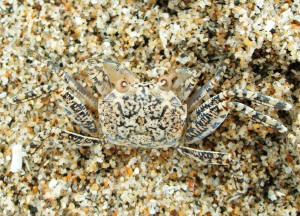
|
Re: Peruvian shore crab identification
2/20/11
Thank you. However, in light of your comment about climbing and the
fact that I see Aratus pisonii is an inhabitant of mangrove swamps,
I ought to mention (and sorry that I did not do so before) that
these crabs were burrowing in the sand of the beach, and that this
stretch of coastline is arid desert, with no appreciable
vegetation. Does that help to narrow it down?
Best regards,
Peter
<Not really. It's one of the Grapsidae, and off the top of
my head, that's the best I can do. As I'm sure you
appreciate, this web site is concerned with species kept in
captivity, mostly fish, corals and so on. So even though I am a
marine biologist on paper at least, sometimes the best you can do
when identifying things from a single photo is to give a family
level designation. If you need a species-level identification, then
you should make an appointment to meet with the Crustacean
department of the Natural History Museum in London. They may or may
not charge a fee, depending on whether you need this identification
for purely personal reasons or as part of a commercial project,
e.g., selling photos to publishers. I used to work at the NHM and
if approached with courtesy, most of the researchers there are very
generous with their time. Otherwise some time spent in an academic
library reviewing the Grapsidae of the Pacific coast of South
America will help you identify the species yourself. Cheers,
Neale.>
Re: Peruvian shore crab identification 2/20/11
Thank you. I have entomology contacts at the nhm so will probably
follow that suggestion.
<Cool.>
Meanwhile I have found a review of burrowing land crabs of the
world and checked each species whose stated distribution includes
the Lima area, and one of them are anywhere our beast in
appearance. All of them also seem much larger. I agree that the
Aratus looks like it; it's just the habitat which is wrong.
I'll see what more I can find on that genus, after which it
will be the museum.
Thanks again,
Peter
<Happy to help. Cheers, Neale.> |
|
Mystery Crab: Hairy Xanthid or Pilumnid --
1/29/11
Hey crew!
<Hey there, Lynn here today!>
Thanks for taking the time to read my email, as this is the first
time I have contacted you directly, though I have spent countless
hours pouring through page after page of your wonderful
guidance!
<That's great to 'hear', thank you! What can I do
for you?>
I recently purchased a piece of LR from someone who was
"trading" it in at my LFS. There are several pieces of
coral on it, i.e. Ricordea, Kenya tree, Zoas,
<Neat>
...but the most interesting find, (I'm assuming this crab
came as a tag-a-long with this rock, as I've never seen it
before in my tank). Just looking for a little help identifying
this rascal. I've attached a picture of this hairy beast.
<Thanks, it sure is a hairy little beast isn't it?
Unfortunately, I can't identify it to species level because
there are just too many possibilities. What I can tell you is
that it's more than likely a Xanthid (family Xanthidae) or Pilumnid (family Pilumnidae) of some sort and that similar
individuals are often referred to as 'teddy bear' crabs.
It's important to note that these are opportunistic omnivores
that I would not trust in mixed systems (fishes, corals, or other
invert's). I'd move the hairy beast to a sump, separate
tank, or find it a new home. If you do decide to keep it, be sure
to offer a variety of meaty bits of marine origin (shrimp, squid,
fish, clam, etc.) or "sinking" pelleted foods. Do enter
the term 'teddy bear crab' in our Google search engine
for more related FAQ's and info:
http://www.wetwebmedia.com/Googlesearch.htm >
Any and all help is greatly appreciated!
<You're very welcome! Take care, Lynn Z>
|
|
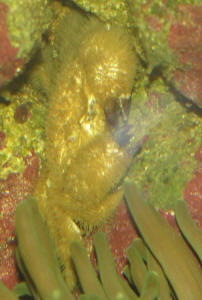
|
|
crab identification 11/14/10
Hi! We live in Florida and visit the beach often... On one of my
daughter's shell collecting trips, we inadvertently brought
back a crab. He was about the size of a pencil eraser about a
month ago, and instead of letting him die, we put him in one of
our tanks... He is now about the size of a quarter. So far, he
has been fine in our tank and not hurting anyone... Do you know
what kind of crab he is? Is he safe in our tank, or should we set
him free? Thanks for your
help!
<Mmm, appears to be a Xanthid of some sort... perhaps try
looking up the family name (along with type locality, or
Caribbean) as it gets a bit older, larger... It may well become
"too pinchy" for your other livestock in time. Bob
Fenner>
|
|

|
|
|

